#Callery Pear Tree
Explore tagged Tumblr posts
Text
Callery Pear Tree Invasive Species
Callery pear trees (Pyrus calleryana), native to China and Vietnam, have been popular ornamental trees for almost 200 years. These trees were introduced to the United States in the 1800s and are often planted along streets and sidewalks because of their attractive form and coloration. This species is also known for its disease resistance (particularly fire blight resistance.) However, Callery pear tree is an invasive species, so much so that nurseries will no longer be allowed to sell the plant in Pennsylvania in 2024.

Callery Pear Tree Appearance
Callery pear has a distinctive appearance with crucial aspects that can help homeowners and plant health care experts quickly identify the plant.
Size: Callery Pear trees typically grow to around 16 to 26 ft tall, or approximately 5 to 8 meters, often with a conical to rounded crown.
Leaves: The leaves are oval-shaped and about 1-1⁄2 to 3 inches long, with a dark green color in early spring before the leaves turn yellow, orange, or red in the fall.
Flowers: The flowers are white and grow in clusters, have about five petals, and are about 3⁄4 to 1 inch in diameter.
Fruits: The fruits of the Callery pear are small, less than 3⁄8 of an inch in diameter. In addition, the fruits have a rugged, almost woody feel but are softened by frost, after which birds readily consume them.
Damage Caused by Callery Pear
Callery pear trees are invasive plants in many parts of the country and have damaged the landscapes and gardens of Pennsylvania homeowners. One of the significant reasons Callery pears cause so much damage is how the trees grow. These trees form dense thickets which displace native plants and animals. The dense thickets push out native trees or other plants that may compete with the Callery pear for water, soil, and space.
In addition, some cultivars (a type of cultivated plant that people have selected for desired traits), such as the ‘Bradford pear,’ are susceptible to storm damage, becoming disfigured or killed by strong winds and winter weather. So there is also a risk of the branches falling during strong winds and storms and damaging other things around the tree, like property or people.
What Makes Callery Pear an Invasive Plant
Like other species of plants we have discussed in this series, Callery pear has many qualities that enable the tree to spread quickly. One primary reason is the fruits discussed previously. The tree species produce large quantities of fruits that birds consume, and then those birds fly and relocate to new areas, passing the seeds in droppings into the soil, allowing new Callery pear trees to grow.
What makes Callery pear unique among the other invasive plant species we have talked about is the role of cultivars in spreading its population. Cultivars were initially bred to produce sterile fruit. However, different varieties can cross-pollinate, which results in viable seeds. When these cultivars grow close enough to each other to cross-pollinate, the trees produce fertile seeds that can sprout once dispersed.
Treating & Controlling Callery Pear
Callery pear can be challenging to control, but some methods exist for managing or removing the population from a landscape.
Small plants and their roots can be removed by hand, but larger trees require more extensive removal with specialized equipment, and herbicide application must be used as a follow-up.
Foliar herbicide applications can be done from around mid-May to early-mid October. These foliar treatments are ideal for landscapes with a low to moderate density of trees, which are less than 10 feet tall.
Basal bark treatments can be applied to the stems of a Callery pear tree throughout the year, with some exceptions (particularly during snow or rainy weather.)
As always, these control and treatment options require specialized, extensive knowledge of plant health care techniques. So call a plant health care expert if you need help with Callery pear in your landscape.
Contact Burkholder PHC for Expert Treatment of Plant Health Care Issues
The Callery pear tree invasive plant can overtake landscapes, and its dense thickets prevent native plant species from growing. To keep your landscape and native species healthy and able to thrive, we recommend a professional evaluation to help remove the plant and control any adverse effects. Our evaluation is free, and the proper treatments can help improve the health of your landscape. Contact Burkholder PHC today for a free consultation.
Blog is originally published at: https://www.burkholderphc.com/callery-pear-tree-invasive-species/
It is republished with the permission from the author.
0 notes
Text
Late night wishful thinking but like
I think planting funky things around retention ponds should be more normalized!!
Like okay I get it retention ponds are meant to hold the runoff water from parking lots and drive throughs and the like so they aren’t exactly the cleanest water around. But like!!! Maybe this is different in other areas, but the only plants I ever see grow around retention ponds are cattails!! Which, like, are fine and great and dandy lets go cattails, but like
Where’s the whimsy?? Where are the flowers?? If I’ve got to see retention ponds whenever I go to a store or drive down the highway or pick up food for my mom, at least bring in some flowers!!
And it’ll benefit so much! A wider variety of plants can make it a more welcoming home to wildlife! Maybe the plants will filter some of the runoff stuff and the water can then be nicer for even more wildlife! Maybe the flowers can be a nice food source for butterflies and bees on their journeys and day trips!! And humans like seeing things be pretty!
Maybe its easier said than done! Maybe most places already do this and its just my city or state that doesn’t really I’d be willing to believe that! But lets get some color in these goddamn retention ponds!!
Swamp milkweed! Aquatic milkweed! Pickerelweed! Water lilies! Irises! Cardinalflower! Fuck it, put some goddamn duckweed in there!! Get some color in those things or so help me!!
#out of queue#ani rambles#solarpunk#gardening#pond gardening#‘ani why not just guerrilla garden in the retention ponds’ im not THAT good at starting plants#and ive yet to have success guerrilla gardening as is!!!#i think there should be like a volunteer group that just rocks up like ‘hey we’ll make your retention pond bomb as fuck and still functional#FOR FREE. and we can start next saturday!!!#also SOMEONE MANAGE THE INVASIVE PLANTS AROUND RETENTION PONDS!!!!#i saw a pond that I was 60% positive was surrounded by callery pear trees#i couldnt be 100% sure because I was actively driving but yknow!!!#‘oh all the water drains to here lets put a pond there to hold the draining water’ THATS HABITAT NOW#CARE FOR THE HABITAT YOUVE CREATED#YES I KNOW THIS IS A POND IN A WALMART PARKING LOT I DONT CARE. WHATS GOING ON IN THERE. BEAUTIFY IT#‘ani why dont you start the group’ idk much about growing aquatic/wetland plants#maybe ill bring it up if i ever go to a florida native plant society meeting who knows#its 1:30 am gnight
483 notes
·
View notes
Text

#Bradford pear#Callery pear#pear tree#invasive species#invasive plants#plants#botany#ecology#native plants
195 notes
·
View notes
Text


Sunday March 30th 2025 4:18pm
11 notes
·
View notes
Text
Corinne and I want to get into fragrances so we got some sample ones and I really wanted to try secretions magnifiques from etat libre d'orange (the one that people say smells like cum) so we got that as one. Corinne tried it on and so far has described it as smelling like "a baby born in a tidepool," "mermaid breastmilk," "feminine but only if all the women you know are evil," and "sucking off Jeremy fragrance but he just got out of the ocean"
#its honestly not as gross and unpleasant as people make it out to be. theres a certain je ne sais quoi#to me its like a callery pear tree drenched in sea water#from the same perfumer we also got jasmin et cigarette#which smells like the dressing room of a heavily perfumed actress in an old theater where you used to be able to smoke indoors#super intense jasmine and vaguely smoky. not tobacco but actual cigarette smoke#we have a bunch more but we're gonna try them at a later date
23 notes
·
View notes
Text
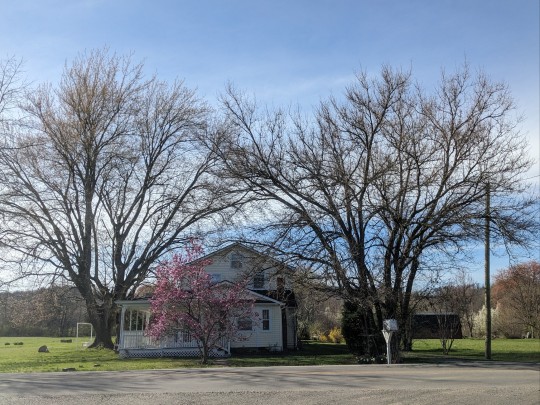
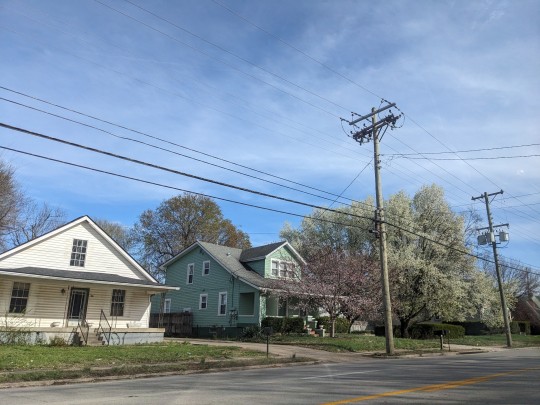
Flowering trees; saucer magnolia, cherry blossom, and the dreaded callery pear
#landscape#landscape photography#photography#nature#nature photography#naturecore#trees#flowers#march#spring#cherry#cherry blossom#saucer magnolia#magnolia#callery pear#bradford pear#kentucky
23 notes
·
View notes
Text
Been sitting on campus for 2 hours and still havent had a man that looks exactly like logan howlett show up and flirt with me
#no just construction dudes that are NOT my type#and occassional students who look just as tired as me#van rambles#and a guy that looks like logan paul#also can smell thsoe fuckass callery pear trees too
6 notes
·
View notes
Text

"Leave Me Lost"
Originally taken May 2018
One of my favorites, reposted for repostober.
#compass#blossoms#flowers#spring#nature#original photographers#photographers on tumblr#photography#lensblr#repostober#my photography#it's a bradford/callery pear tree if anyone's wondering what kind of blossoms#'cause i know i would XD
27 notes
·
View notes
Text

brooklyn
4 notes
·
View notes
Text

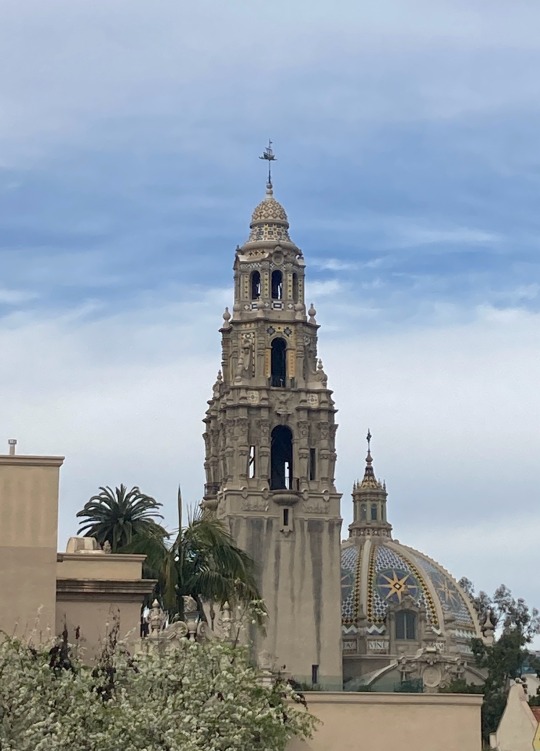
#balboa park#museum of man#bell tower#architecture#bertram g goodhue#flowering trees#callery pear#pyrus calleryana#el cid campeador#statues#anna hyatt huntington#san diego
2 notes
·
View notes
Text




Friday, March 28th 2025 11:35 to 11:36 a.m.
7 notes
·
View notes
Text
Also, Bradford Pears (callery pears) trees should be illegal.
#bradford pear#callery pear#trees#they smell like ass#i hate them#they're invasive too#well they are in the US at least#im tired of smelling them#i want them gone#they kill native plants because they take over everything#why does everyone want ass trees?#their roots are shallow too#bradford pear hate train
0 notes
Text

oh yeah the cum tree is in bloom!!!!!!!
#bradford pear#I LOVE THE SMELL OF THIS TREE. I DON'T THINK IT'S OFFENSIVE AT ALL#in fact it goes hard with the smell of decomp#this is a horror story from my hometown actually. someone got evicted and trashed a house but#more importantly they left a freezer full of meat. like 200+lbs. in warm weather.#landlord doesn't go check the property bc they're not local so a weird smell develops over several blocks#people are like wtf? do the callery pears smell extra bad this year?#and me? i would walk to that area specifically bc the smell was intoxicating. weird flowers with a hint of something almost fruity...#turns out it was the smell of rotten meat with the odd smell of the tree blossoms masking it and making it worse for some ppl but#for me? i wish i could bottle that smell and take a whiff when im uninspired. i know i will never smell it again... but. IF I DO#then i at least know to call non emergency and be like hey. do you guys wanna look for a body?
1 note
·
View note
Text
We have an invasive pear species where I live because people planted two types of ornamental pears thinking they were sterile and couldn't hybridize. They hybridized alright, and now they're invasive and absurdly hard to kill.

Man look how much of this tree we lost :( it completely shaded our balcony before. It's one of those ornamental shitty pear trees though, like they're all doomed to fall apart eventually.
150 notes
·
View notes
Text


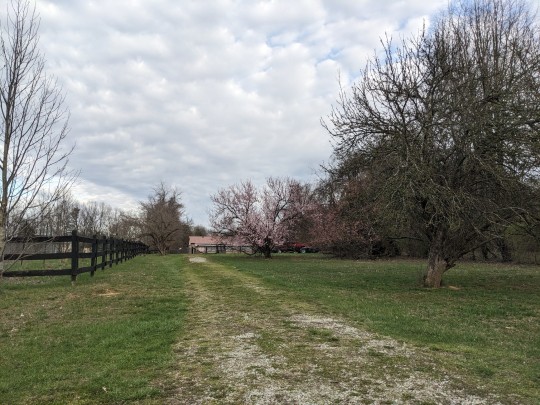

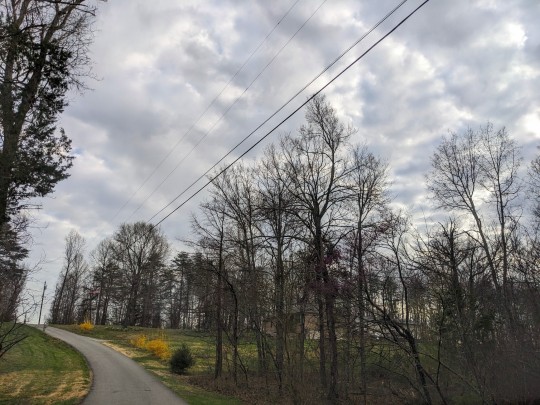


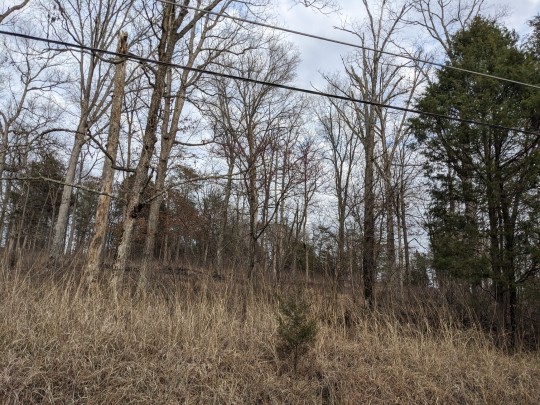

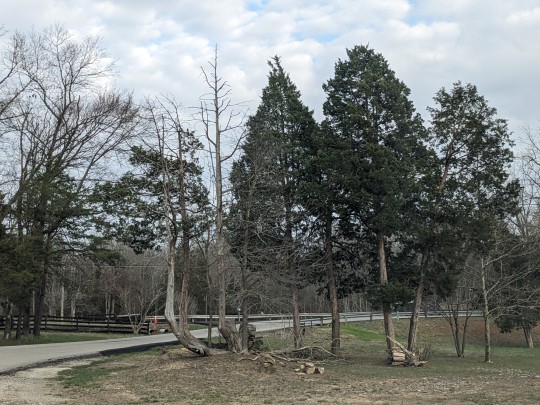
Creek barrens
#landscape#landscape photography#photography#nature photography#naturecore#trees#flowers#plants#woods#forest#spring#march#redbud#cercis#prunus#cherry#peach#callery pear#bradford pear#forsythia#juniperus#daffodils#rural#kentucky
20 notes
·
View notes
Text
i hope i reincarnate into one of those trees that smells like cum
0 notes